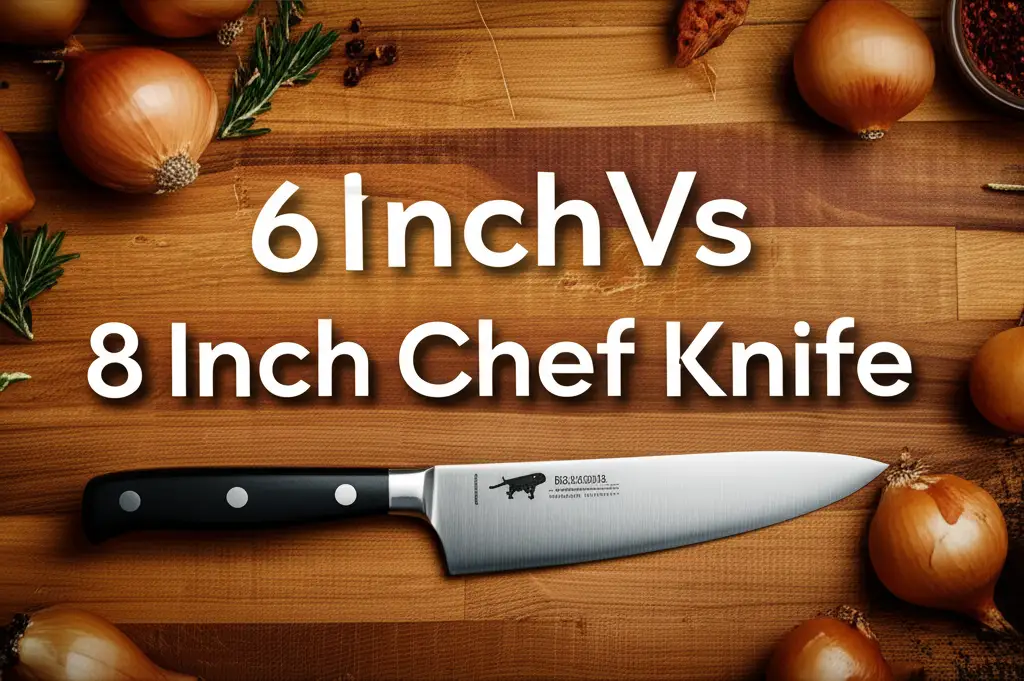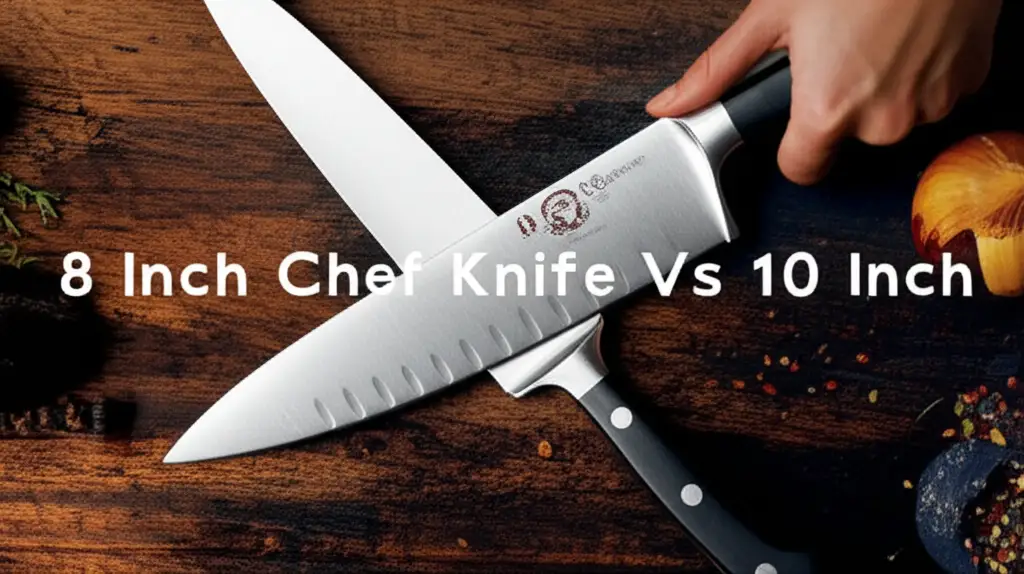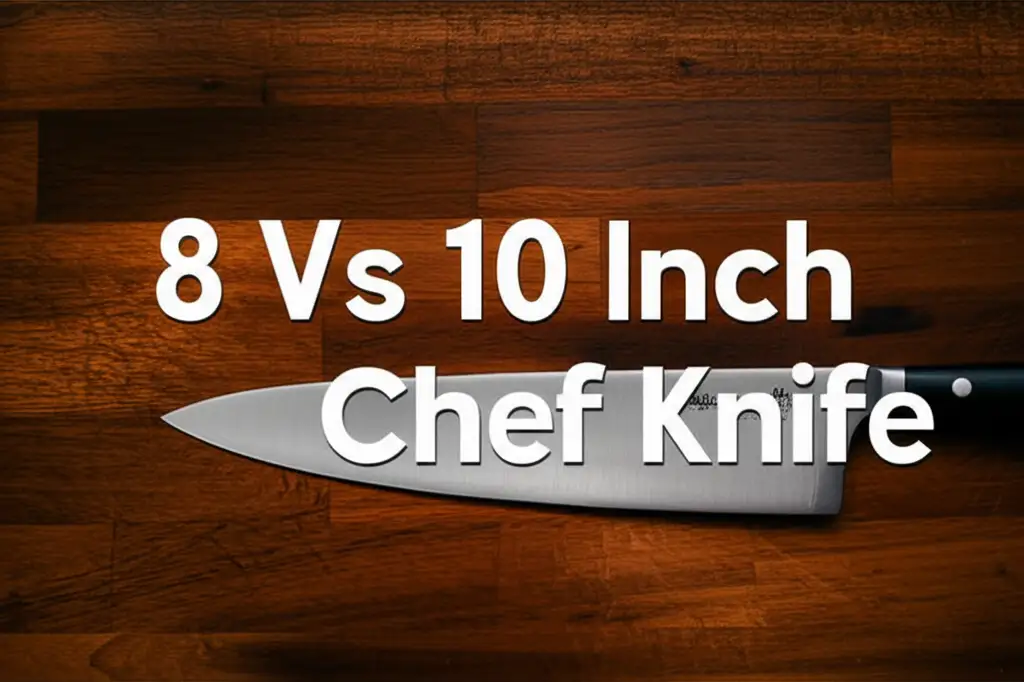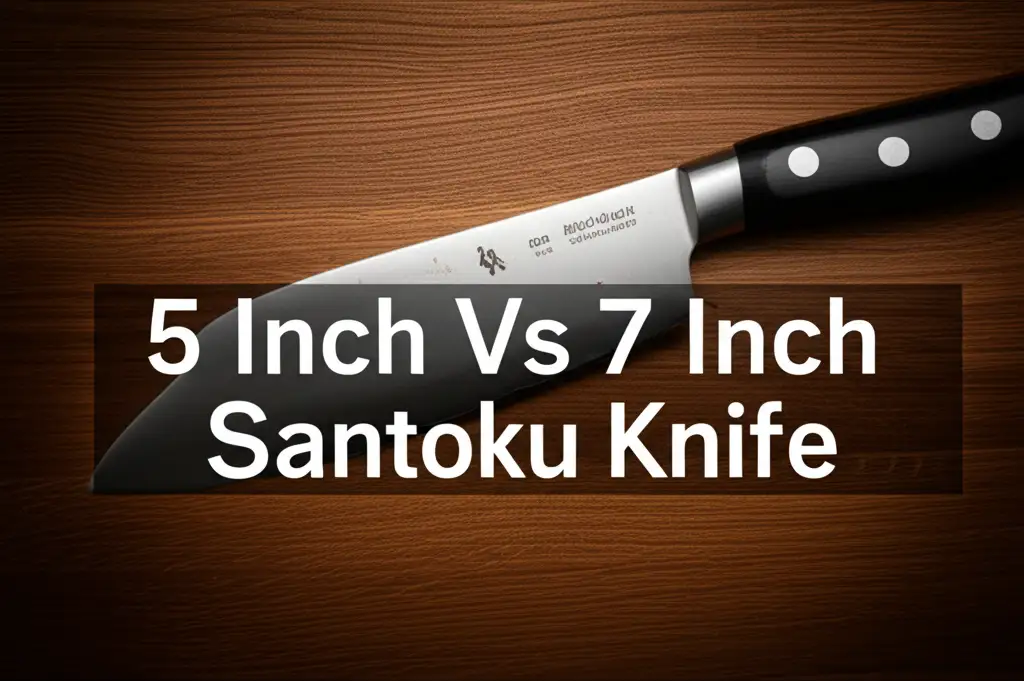· Elira Thomsen · Kitchen Tools · 15 min read
6 Inch Vs 8 Inch Chef Knife

6 Inch Vs 8 Inch Chef Knife: Choosing Your Perfect Blade
Choosing the right chef knife feels like a big decision. Many home cooks and even professional chefs often stand at a crossroads. They ask themselves: “Do I really need an 8-inch blade, or is a 6-inch chef knife enough?” This choice matters for your comfort, safety, and efficiency in the kitchen. Each knife size offers distinct advantages and disadvantages. Understanding these differences helps you make an informed decision.
This article will explore the specific features of both the 6-inch and 8-inch chef knives. We will discuss their strengths in various kitchen tasks. We will also cover ergonomics, user preference, and maintenance. By the end, you will know which chef knife is the better fit for your cooking needs. Let us dive into the details.
Takeaway
- 6-inch chef knives offer more control and precision for smaller hands or intricate tasks.
- 8-inch chef knives provide greater efficiency for large-scale chopping and bigger ingredients.
- Consider hand size and comfort as primary factors for both safety and performance.
- Match the knife size to your common cooking tasks for optimal results.
- Proper maintenance is essential for the longevity of any chef knife, regardless of size.
A 6-inch chef knife gives precise control for delicate tasks and suits smaller hands. An 8-inch chef knife handles larger ingredients and offers efficient chopping for bigger volumes. Your best choice depends on personal comfort, cutting style, and the typical food you prepare.
Understanding Chef Knife Lengths: 6 Inch Vs 8 Inch
Chef knives are kitchen workhorses. Their length significantly impacts how you use them. The difference between a 6-inch and an 8-inch chef knife might seem small. However, this two-inch variation changes the knife’s feel and function. A chef knife’s blade length is measured from its tip to the heel, where the blade meets the handle. This measurement defines its reach and leverage.
A 6-inch chef knife has a shorter blade. This shorter blade makes it feel more nimble. It is easier to maneuver in tight spaces. You get more control over the tip for detailed cuts. Many find this size less intimidating. It is often a good starting point for new cooks.
An 8-inch chef knife features a longer blade. This length provides more cutting surface. It handles larger items with ease. You can chop more vegetables in one stroke. This size offers greater leverage for tough ingredients. It is a common choice for professional kitchens. The length allows for the rocking motion often used in chopping.
Your choice of blade length affects your comfort and confidence. A knife that feels right in your hand improves your cutting technique. It also helps prevent accidents. We will explore specific benefits and drawbacks for each size next. Understanding these points helps you select the right tool. It is important to know how each knife performs with common kitchen tasks.
The Agility Advantage: Benefits of a 6 Inch Chef Knife
The 6-inch chef knife excels in precision and control. Its shorter blade is less intimidating. This makes it a favorite for many home cooks. People with smaller hands often find it more comfortable to grip and use. The reduced length means less weight, which helps reduce hand fatigue during long prep sessions. This knife is perfect for detailed work.
You will find the 6-inch chef knife very useful for delicate tasks. It handles precise slicing of small fruits like strawberries. It is also excellent for mincing garlic or shallots. The shorter blade allows you to navigate around bones or trim fat with accuracy. If you frequently work with smaller ingredients, this knife becomes an extension of your hand. It offers superior maneuverability.
This knife is also a great choice for beginners. Its size helps build confidence. You learn proper knife skills without feeling overwhelmed by a larger blade. It encourages better control over your cuts. This focus on control can improve safety in the kitchen. Even experienced cooks keep a 6-inch chef knife for specific jobs. It complements an 8-inch knife well, providing versatility in your kitchen arsenal.
Using the right tool for the job makes cooking enjoyable. A 6-inch chef knife provides the agility needed for intricate food preparation. Think about preparing a complex garnish or thinly slicing herbs. This knife delivers the precision you need. It gives you the confidence to perform detailed culinary tasks.
The Power and Reach: Why Choose an 8 Inch Chef Knife
The 8-inch chef knife is a versatile workhorse in any kitchen. Its longer blade provides significant advantages. This knife handles larger ingredients with ease. It cuts through melons, squash, or large cuts of meat efficiently. The extra length allows for a longer, continuous cutting stroke. This means you can chop more food with fewer motions.
This size is ideal for high-volume chopping. If you prepare meals for many people, an 8-inch chef knife saves time. It allows you to chop large piles of vegetables quickly. The length also provides greater leverage. This makes it easier to slice through tough rinds or dense vegetables. Many professional chefs prefer this size for its power and efficiency. It allows for the classic “rocking” motion used to mince and chop herbs.
An 8-inch chef knife often feels well-balanced in larger hands. The added weight helps the blade do the work. You do not need to apply as much force. This reduces strain during extended cutting tasks. It helps maintain a comfortable grip. This knife is also excellent for one-cut wonders. You can slice through a baguette or a roast in a single pass. This creates cleaner cuts and more appealing food presentation.
Choosing an 8-inch chef knife means prioritizing efficiency and capacity. It is a fantastic tool for general kitchen tasks. It is strong enough for heavy-duty work. It is also nimble enough for most everyday chopping and slicing. Consider your typical cooking needs. If you handle big ingredients or cook often, this knife size brings immense value to your kitchen.
Ergonomics and Comfort: Finding Your Fit
Knife comfort is crucial for safe and efficient cooking. The feel of a chef knife in your hand determines how well you use it. This often comes down to ergonomics. Ergonomics considers how a tool fits the human body. For chef knives, this means handle size, weight, and blade balance. A good fit reduces strain and improves control.
Hand size plays a significant role in comfort. People with smaller hands often find a 6-inch chef knife more manageable. Its shorter blade and lighter weight feel less unwieldy. This allows for a more secure grip. A secure grip prevents slipping and improves cutting accuracy. Conversely, those with larger hands might prefer the weight and bulk of an 8-inch chef knife. It fills their hand better and provides a sense of stability.
Balance is another key factor. A well-balanced knife feels like an extension of your arm. The weight should distribute evenly between the blade and the handle. An 8-inch knife might feel blade-heavy to some. A 6-inch knife might feel handle-heavy to others. Test different knives to find what feels right for you. Poor balance leads to more effort during cutting. This increases fatigue.
Ultimately, your personal preference matters most. What feels comfortable for one person may not for another. Consider how much pressure you apply when cutting. Think about the angle of your wrist. A knife that aligns with your natural movements will be safer and more effective. It is always wise to hold and feel knives before buying them. This helps you select the perfect chef knife for your unique needs.
Kitchen Tasks and Versatility: Which Knife Excels Where?
Different chef knife sizes perform better for specific kitchen tasks. Understanding these differences helps you choose the right tool for the job. This improves both efficiency and safety in your cooking. A 6-inch knife shines in certain areas. An 8-inch knife dominates in others.
The 6-inch chef knife is a master of precision. It works perfectly for slicing small vegetables like garlic cloves or ginger. You can dice shallots very finely with it. It is also ideal for trimming fats from meats. Its shorter length gives you excellent control over the blade tip. This makes it great for delicate work. For instance, when you need to clean mushrooms for a recipe, this knife offers the control needed for delicate parts. Learning how to clean mushrooms properly ensures better results. This knife is also good for peeling fruits or vegetables. Its compact size means it easily fits into smaller spaces on your cutting board.
The 8-inch chef knife is a powerhouse for general prep. It excels at chopping large quantities of vegetables. Think about dicing multiple onions or slicing several carrots. Its long blade allows for smooth, sweeping cuts. This reduces the number of strokes you need. It is also effective for cutting through large fruits like melons or pineapples. The extra length provides leverage for tougher skins. For slicing roasts or breaking down a chicken, the 8-inch knife offers the necessary reach. It handles dense ingredients like potatoes or sweet potatoes with ease.
While both knives are versatile, one may offer a better experience for your most frequent tasks. If you often prepare large family meals, the 8-inch knife is likely more efficient. If you cook for one or two and focus on detailed dishes, the 6-inch knife might be your go-to. Many kitchens benefit from having both. This way, you have the right tool for every cutting challenge.
Maintenance and Storage: Keeping Your Chef Knife Ready
Proper maintenance extends the life of any chef knife. This includes cleaning, sharpening, and safe storage. The size of your chef knife can impact these practices slightly. Regardless of size, a well-maintained knife performs better and lasts longer. Taking care of your knives is just as important as taking care of your entire kitchen. This includes regularly cleaning parts like your refrigerator for overall kitchen hygiene. Keeping your refrigerator clean prevents food contamination.
Cleaning your chef knife is essential after every use. Wash it immediately with warm, soapy water. Use a soft sponge or cloth. Never put chef knives in the dishwasher. The harsh detergents and high heat can damage the blade and handle. Dishwashers can also make knives dull. Dry your knife thoroughly to prevent rust. This step is critical, especially for carbon steel knives. A clean knife is a safe knife.
Sharpening keeps your blade keen. Both 6-inch and 8-inch chef knives require regular sharpening. The technique is similar for both sizes. Use a sharpening steel or a whetstone. A longer blade might require a bit more practice on a whetstone to maintain a consistent angle. However, the principles remain the same. A sharp knife is safer than a dull one. A sharp blade glides through food. A dull blade can slip, causing accidents. You can also send your knives for professional sharpening.
Storing your chef knives safely is crucial. Do not store them loose in a drawer. This dulls the blade and creates a safety hazard. Use a knife block, a magnetic strip, or blade guards. Knife blocks protect the edge and keep knives organized. Magnetic strips display knives beautifully and keep them accessible. Blade guards offer protection when storing knives in a drawer. Proper storage protects your investment. It also ensures your knives are ready for your next cooking adventure.
Durability and Material Considerations
The durability of a chef knife depends more on its material and construction than its size. However, heavier use often leads to more wear. An 8-inch knife, used for heavier tasks, might experience different stresses than a 6-inch knife. Understanding knife materials helps you choose a durable tool.
Most chef knives use stainless steel. This material resists rust and corrosion well. High-carbon stainless steel offers a good balance of sharpness and durability. It holds an edge longer than standard stainless steel. Carbon steel knives are very sharp but require more care. They can rust if not dried immediately. Carbon steel also develops a patina over time. This patina protects the blade.
Knife construction also affects durability. Full tang knives are generally more durable. A full tang means the blade extends all the way through the handle. This provides strength and balance. Partial tang knives are less robust. The handle material also plays a role. Wood, composite, and synthetic materials are common. Wood handles offer a classic look but need oiling. Composite and synthetic handles are often more water-resistant and durable.
The thickness of the blade matters too. Thicker blades are stronger. They handle heavy-duty chopping better. Thinner blades are better for precision slicing. An 8-inch knife often has a slightly thicker blade than a 6-inch knife. This contributes to its ability to handle tougher ingredients. When buying, look for reputable brands. They often use higher quality materials and construction. Investing in a good quality knife means it will last for many years. Proper care will ensure its longevity.
Making Your Decision: Factors to Consider When Choosing
Choosing between a 6-inch and an 8-inch chef knife boils down to personal factors. There is no single “best” knife for everyone. Your cooking style, kitchen space, and comfort level all play a role. Take time to think about how you cook. Consider what tasks you perform most often.
First, think about your hand size and strength. A knife should feel like a natural extension of your arm. If you have smaller hands, a 6-inch knife offers more control. It prevents strain. If you have larger hands, an 8-inch knife might feel more secure. It provides better leverage. Hold both sizes if possible. See which one feels more balanced and comfortable in your grip.
Next, consider the type of cooking you do. If you prepare large meals frequently, an 8-inch chef knife will be more efficient. It handles big vegetables and large cuts of meat easily. If you mostly cook for one or two people, a 6-inch knife might be sufficient. It excels at precision tasks and smaller ingredients. It takes up less drawer or knife block space too.
Your cutting board size also matters. An 8-inch knife needs a larger cutting surface. If you have a small kitchen counter or cutting board, a 6-inch knife is more practical. It reduces the risk of hitting the counter or your fingers. Think about your preferred cutting technique. If you use a rocking motion extensively, an 8-inch knife facilitates this better. If you prefer a lot of push-cuts or intricate slicing, a 6-inch knife might be more agile.
Finally, consider your budget. Quality knives are an investment. Sometimes, buying one high-quality 8-inch knife is better than two lower-quality knives. Or, a high-quality 6-inch knife might be a good starting point. Many professional cooks own both sizes. This provides maximum versatility for all kitchen tasks. Make a choice that supports your cooking habits and comfort.
Frequently Asked Questions
Is a 6-inch or 8-inch chef knife better for beginners?
A 6-inch chef knife is often better for beginners. Its shorter blade offers more control. It feels less intimidating. This helps new cooks learn proper knife techniques safely. It reduces the chance of accidents. Many find it easier to handle for precise cuts.
Can an 8-inch chef knife be used for small tasks?
Yes, an 8-inch chef knife can be used for small tasks. Experienced cooks often use it for everything. However, its length might make delicate tasks like mincing garlic feel less precise. It requires more control and practice for small jobs.
What tasks are 6-inch chef knives best for?
6-inch chef knives are best for precision tasks. They excel at mincing garlic and herbs. They are great for slicing small fruits and vegetables. They also work well for trimming meat and fat. Their smaller size provides excellent control for detailed work.
How do I choose between a 6-inch and 8-inch chef knife?
Choose based on your hand size, comfort, and common cooking tasks. Smaller hands often prefer a 6-inch knife for control. Larger hands might find an 8-inch knife more comfortable. If you prep large quantities, the 8-inch is efficient. For detailed work, the 6-inch excels.
Does knife weight vary significantly between 6-inch and 8-inch knives?
Yes, knife weight varies significantly. An 8-inch chef knife is generally heavier than a 6-inch one. The extra length of the blade contributes to this added weight. This weight can provide leverage for chopping but may also cause fatigue for some users.
Conclusion
Deciding between a 6-inch vs 8-inch chef knife comes down to understanding your personal cooking needs. Both sizes serve distinct purposes in the kitchen. The 6-inch chef knife offers superior control and precision. It is perfect for delicate tasks and smaller ingredients. It suits those with smaller hands or anyone learning knife skills. On the other hand, the 8-inch chef knife provides power and efficiency. It excels at handling large ingredients and high-volume chopping. It is often preferred by experienced cooks and those who cook frequently.
Your best choice should prioritize comfort, safety, and efficiency. Consider the size of your hands, the types of food you prepare most often, and your preferred cutting techniques. Investing in a quality chef knife, regardless of its size, transforms your cooking experience. A well-chosen knife becomes an indispensable tool. It makes food preparation more enjoyable and effective.
Ready to find your perfect chef knife? Visit a local kitchen store. Hold both the 6-inch and 8-inch options. Feel the balance and comfort in your hand. This hands-on experience will guide you to the right blade for your culinary adventures. Happy cooking!





